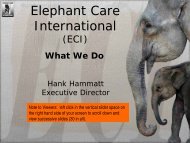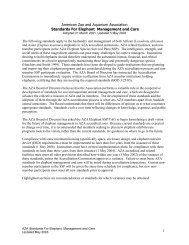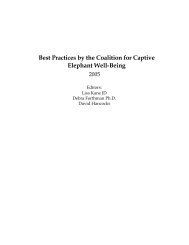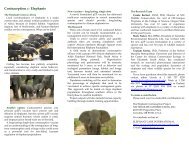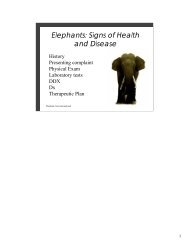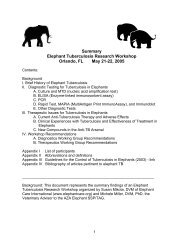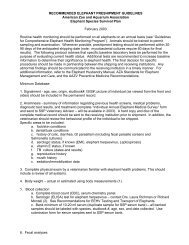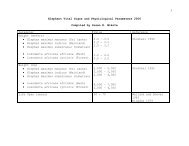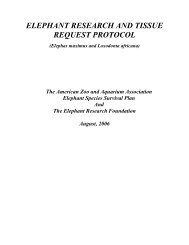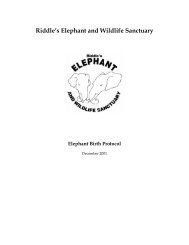Nepal Elephant TB Control and Mgt Action Plan.pdf - Elephant Care ...
Nepal Elephant TB Control and Mgt Action Plan.pdf - Elephant Care ...
Nepal Elephant TB Control and Mgt Action Plan.pdf - Elephant Care ...
- No tags were found...
You also want an ePaper? Increase the reach of your titles
YUMPU automatically turns print PDFs into web optimized ePapers that Google loves.
<strong>Nepal</strong> <strong>Elephant</strong> Tuberculosis <strong>Control</strong> <strong>and</strong>Management <strong>Action</strong> <strong>Plan</strong> (2011-2015)should occur). If more than 30 days of interruptedtreatment occur, treatment must start over. Onlyfull doses count toward the total of 60 doses.Treatment is connued for an addional 10months with INH-RIF. The total number of dosesfor the enre treatment is 360 full doses. Theenre treatment should be completed within 15months. This allows for refused medicaon days<strong>and</strong> periods of interrupon that may be needed ifside effects occur.Compleon of Treatment: Treatment is completewhen an elephant has consumed 60 full dosesof EMB <strong>and</strong> 360 full doses of INH-RIF. There iscurrently no single test that confirms cure. Weightgain, improved exercise tolerance, improvedbreathing, <strong>and</strong> other signs may be used toevaluate treatment response. Other parametersthat signify a response to treatment are underinvesgaon.Post Treatment Policy: A"er successfulcompleon of the prescribed treatment (nogreater than 15 months) an elephant will bereleased back into its home facility <strong>and</strong>/orresume normal acvity. For the first two yearspost-treatment, respiratory samples for culture,PCR, <strong>and</strong> LAMP should be submi#ed every 6months (triple sample method). A"er two years,respiratory samples for culture, PCR, <strong>and</strong> LAMPshould be submi#ed annually (triple samplemethod).Secon 1.6 Human HealthConsideraons<strong>TB</strong> can be transmi#ed between elephants <strong>and</strong>humans (Michalak et al. 1998). It is recommendedthat elephant h<strong>and</strong>lers <strong>and</strong> other exposed staffwear N-95 masks when working in close contactwith <strong>TB</strong> posive elephants. N-95 masks are specialmasks that are cerfied to be protecve against <strong>TB</strong>.The mask must be secured ghtly around the faceto be effecve. Wearing masks for the duraonof treatment is ideal; at minimum masks shouldbe worn for the first 3 months. H<strong>and</strong>lers shouldbe instructed to wash their h<strong>and</strong>s a"er workingdirectly with suspect or infected elephants. All newelephant h<strong>and</strong>lers or other staff working in closecontact with elephants should be screened for <strong>TB</strong>before starng employment. An annual human<strong>TB</strong> screening program for all staff is essenalas exposure from outside sources may occur atany me. Human <strong>TB</strong> tesng services are widelyavailable in <strong>Nepal</strong>. Documentaon of staff <strong>TB</strong>tesng will be required for elephant owners orfacilies to receive Cerficates of Compliance.Note that the <strong>Elephant</strong> <strong>TB</strong> Stat-Pak ® may remainposive even a"er treatment, so cannot be usedto determine re-infecon or treatment failuresin elephants that have been treated. The MAPIAdeclines with treatment (Lyashchenko et al.2006) <strong>and</strong> it is expected that the intensity of thereacon on the DPP ® Vet<strong>TB</strong> test may also changepost-treatment, however further research inthis area is needed. Post-treatment monitoringguidelines may change as new informaon ortests become available.15



